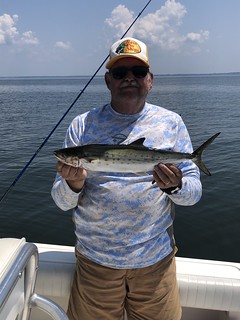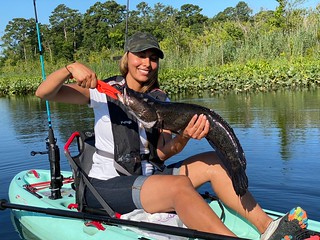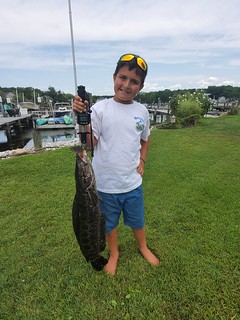Maryland Fishing Report – August 4

Evelyn Wike spent a weekend morning fishing for white perch with her dad near Annapolis. The smiles in this selfie say it all. Photo by Christopher J. Wike
Summer is a time to enjoy the outdoors with family and friends and few things can be more rewarding than fishing with sons and daughters.
With striped bass fishing resuming this week, anglers should continue to check the striped bass fishing advisory forecast to help protect this iconic species during harsh conditions.

Forecast Summary: August 4 – August 10:
While last week was generally cooler, this week will bring back the sunny, very warm weather and should bump up those Maryland Bay water temperatures. Bay surface water, river, and steam temperatures are still warm even after dropping a few degrees down to the low 80s. Monitoring data is showing main Bay bottom waters are still slightly cooler than surface waters, and continue to show poor oxygen conditions. As a result, Bay gamefish will likely be higher in the water column to find adequate oxygen and their preferred water temperatures. The coolest oxygenated bottom waters can be found from the Kent Island area north to Tolchester. Due to evening Conowingo Dam releases, cool water is also present on the Susquehanna River through the Susquehanna Flats area in the late evening and early morning. Bay surface temperatures cool by 2 to 3 degrees at night.
Due to low bottom oxygen levels, avoid fishing below the following depths in these locations: Swan Point, 25 feet, Bay Bridge to Bloody Point, 10 feet to 20 feet; Choptank River to Point No Point, 15 feet to 35 feet. On the Potomac River from Colonial Beach to Piney Point, avoid fishing deeper than 5 feet to 35 feet. Conditions can vary daily so be sure to check the depth-to-oxygen level online prior to your next fishing trip.
Maryland upper Bay waters down to the Bay Bridge are running saltier than normal while the bay waters below the bridge are normal. Expect average flows for most Maryland rivers and streams. There will be above average tidal currents all week as a result of the upcoming new moon Aug. 8. Expect average clarity for Maryland portions of the Bay and rivers, with very poor water clarity due to algal blooms in the Northeast, upper Bush, Back, and middle Patuxent rivers. To see the latest water clarity conditions, check Eyes on the Bay Satellite Maps.
For more detailed and up-to-date fishing conditions in your area of the Bay, check the Maryland DNR website for Click Before You Cast. Get regular updates on Maryland’s waters sent to your inbox with our Eyes on the Bay newsletter. Sign up online.
The striped bass season reopened Aug. 1 and it did not take long for anglers to find good striped bass fishing in the Conowingo Dam pool and the Susquehanna Flats area. The best fishing at the dam pool is in the early morning hours for those casting topwater lures and paddletails. The same action is also occurring during the early morning hours along the edges of the Susquehanna Flats. The Conowingo Dam is on an afternoon power generation schedule.
Live-lining spot at the Tolchester Lumps area between Pooles Island and Rock Hall picked up right where it left off before the striped bass closure, and catches have been good. Water temperatures are still elevated so anglers are encouraged to release undersized fish in the water and to curtail fishing once catching the limit of one legal-sized striped bass. Tips on careful catch-and-release practices can be found on the DNR website. Anglers are required to use circle hooks when targeting striped bass, to help prevent deep hooking when fishing with bait or live-lining.
Fishing for blue and channel catfish remains good and many anglers are finding them a welcomed addition to their fishing options. The Susquehanna River remains one of the most productive waters to fish for blue cats and they can also be found in the upper Chester River and to a lesser degree in the other tidal rivers of the upper Bay region. Channel catfish can be found in all of the region’s tidal rivers and also out in the Bay along with blue catfish at times. Northern snakeheads are often part of the mix when fishing in the tidal creeks and rivers of the upper Bay.
Fishing for white perch is a fun and enjoyable experience in the tidal rivers when fishing with light tackle, casting beetle spins, spinners, and small jigs during the early morning and evening hours near shoreline structure. White perch can also be found on many of the hard bottom shoals and knolls in the Bay and bottom fishing is the way to target them. Pieces of bloodworm on a bottom rig tends to be the most popular way to fish. Jigging with a dropper fly is an alternative when schools of white perch can be located.
With the return of striped bass fishing, one of the most popular ways to fish the middle Bay is live-lining spot along channel edges where striped bass can be located with depth finders. The Bay Bridge piers, the outside edge of Hacketts Bar, Thomas Point, Buoy 83, and the False Channel area at the mouth of the Choptank are just a few places worth checking out. Spot can be found in many of the shallower locations in the middle Bay over hard bottom. The inside of Hacketts Bar, in front of Chesapeake Beach, and behind Black Walnut Point on the Choptank are just a few places one can find bait-sized spot.

Gary Hush caught this fine looking Spanish mackerel in Eastern Bay on a twistertail jig. Photo by Bob McMahon
Trolling umbrella rigs deep with bucktails or swimshads as trailers along channel edges is an option. Trolling bucktails dressed with twistertails along shallower channel edges, ballast stone piles, or any structure that can be located. Jigging with soft plastics along channel edges or deep under breaking fish can also work well. Small striped bass and a mix of Spanish mackerel and bluefish will be encountered chasing bay anchovies close to the surface, so keep an eye out for clusters of diving seagulls.
Early risers out on the water at dawn are experiencing good shallow-water fishing for striped bass. The evenings are easier on one’s sleep schedule and do also provide some action. Casting topwater lures near shoreline structure is always a fun and exciting way to fish for striped bass. Casting paddletails also works well where grass is not a problem. Speckled trout can be part of the mix at times, especially on the eastern side of the Bay.
Spanish mackerel have moved into the middle Bay and can be found as far north as Kent Island. Trolling is perhaps the most popular way to fish for them — using small Drone spoons in a variety of colors and small Clark spoons behind #1 and #2 planers and inline weights can work well at trolling speeds around 7 or 8 knots. Drone spoons in gold with chartreuse color combinations are a favorite with many anglers.
Spanish mackerel, small striped bass, and small bluefish are making life difficult for schools of bay anchovies in the middle Bay and often drive them to the surface, drawing the attention of seagulls that can mark the way to the action. Speed reeling small jigs or Got Cha lures through breaking fish is a great light tackle way to fish for Spanish mackerel.
The many docks, piers, and shorelines of the middle Bay and its tidal rivers provide fun and accessible fishing for white perch, no matter one’s age. White perch are often the first fish to be caught by young children and new anglers but also provide plenty of enjoyable fishing for the most experienced.
Fishing with grass shrimp or pieces of bloodworm on a simple one hook bottom rig close to docks and piers or any kind of structure is a simple way to fish for them. Casting small spinners with light tackle or Clouser flies with a light fly rod offer more challenging fishing. A good running tide is needed when fishing with bait from docks or shorelines, and the mornings and evenings offer the best opportunities when casting near shoreline structure.
The arrival of Spanish mackerel is providing plenty of exciting fishing opportunities in the lower Bay. Trolling small Drone or Clark spoons behind #1 and #2 planers and inline weights at about 7 to 8 knots is a popular way to fish for them. The Spanish mackerel are beginning to concentrate enough that they are forming up with small bluefish and chasing schools of bay anchovies, which of course attracts the attention of seagulls when the bait is pushed to the surface. Trolling around this action, but never through it, is a good tactic.
Another good tactic is to carefully come up on the upwind side of the breaking fish, cut your engine and drift towards the action. Casting Got Cha lures or small heavy jigs and speed reeling is a fun, light-tackle way to catch the Spanish mackerel. Make sure to use black swivels and snaps on your leaders since the small bluefish have a habit of snapping at most anything moving through the water and can cut you off.
As the breaking fish action becomes more common, large red drum have a habit of residing underneath the surface action close to the bottom, waiting for injured or dead anchovies to drift down from above. Jigging with large soft plastics can pay off with some rod-bending catch-and-release action.
Cobia fishing is good this week in several locations. The Target Ship area and the Middle Grounds are just two popular locations to chum and chunk. Drifting live eels with a little weight in the back of a chum slick is working well. Fresh menhaden baits drifted back will also work well. When the Bay waters are calm, sight fishing for roaming cobia is always fun and exciting. Casting large soft plastics or live eels will get you into the action.
Legal-sized striped bass can also be found holding close to the bottom underneath breaking fish; jigging with soft plastics can pay dividends. Some anglers are trolling umbrella rigs with bucktails dressed with a twistertail or perhaps a swimshad as a trailer. Tandem-rigged bucktails and swimshads with or without inline weights are usually part of a trolling spread. Channel edges are often the best places to look for suspended fish which can be found holding at 30 feet. The mainstem of the Potomac River has been closed to striped bass fishing since July 7 and will remain closed through August 20. The tidal rivers feeding into the Potomac on the Maryland side are open to striped bass fishing at this time.

Jim Livingston shows off a half bushel of large crabs he caught in the Rhode River. Photo courtesy of Jim Livingston
Casting a variety of lures in the early morning and evening hours along shoreline structure is an excellent way to target striped bass and speckled trout with light tackle. The tidal rivers on both sides of the Bay are good places to target. The Cedar Point Rocks is a popular place to fish along with the cuts through Hoopers Island. The marsh edges, grass beds, stump fields, and small marsh creeks are good places to look for speckled trout on the eastern side of the Bay.
Spot can be found in excellent numbers in the lower Patuxent River, Tangier Sound and other locations throughout the lower Bay region. White perch can also be found at these locations and can be found in the region’s tidal creeks. Flounder are being caught by those who target them in Tangier and Pocomoke sounds as well as the Point Lookout area.
Recreational crabbers are seeing improvement in catches this week and catching a half bushel of good crabs per outing is becoming more common. The best crabbing for some is in waters about 10 feet deep. Many crabbers are reporting quality over quantity when crabbing, with a good portion of the crabs being caught being extra-large.
No matter what type of freshwater fishing you do, the early morning and evening hours often present some of the best fishing opportunities. This time of the year is wonderful for fly fishing in the trout management waters of the western and central regions, where waters are set up for catch-and-release only or restricted to fly fishing only. Matching early morning or evening hatches or terrestrials is often the challenge anglers are seeking.

Anastasia St. Cloud caught this northern snakehead while fishing on the Little Blackwater River in lower Dorchester County recently. Photo by Eric Packard
The upper Potomac River is running low and clear this week and anglers are finding smallmouth bass concentrated in some of the deeper pools. Long casts with light lines and smaller lures is often the ticket to success; soft plastics, crankbaits, and occasionally topwater lures are working well. Deep Creek Lake is in the height of the summer vacation season and anglers are enjoying a wide variety of fishing opportunities.
Fishing for largemouth bass continues in a summer mode of behavior for both fish and anglers. The fish feed mostly at night during the heat of the summer, so if one wants to catch them in the shallower areas, it means being out on the water at dawn or late evenings. Casting topwater lures and lipless crankbaits in the shallows is always an exciting way to fish for largemouth bass. As the day wears on, targeting thick grass beds and any kind of shade is a great tactic with wacky rigged stick worms or soft plastics that are worked slowly and deliberately.
Northern snakeheads are taking center stage in many of the tidal creeks and rivers in the Chesapeake Bay watershed. It is almost impossible to find a creek or river where they do not reside and their populations are expanding rapidly. They have large appetites and are having a dramatic effect on species such as white perch, minnows, American eels, and the list goes on. On the flip side they offer anglers exciting topwater action when casting chatterbaits, frogs, and similar baits, and provide excellent table fare.
Last week we had a swordfish state record, set by angler Peter Schultz and his team off the coast of Ocean City. The swordfish was brought to gaff after an eight-hour battle and weighed in at 301 pounds.
The big event in Ocean City this week is the White Marlin Open, and with a purse exceeding $9 million and 444 boats entered it is no small affair. Anyone fishing near the inlet, the East Channel, or other channels leading from the inlet should watch out for sportfishing boat traffic.
Fishing in the surf of Ocean City and Assateague Island is mostly focused on catching kingfish, spot, and small bluefish. Due to summer temperatures and strong sunlight, the best fishing for kingfish often occurs during the morning hours. Pieces of bloodworm make the best bait for spot and kingfish, while cut bait from spot works well for the bluefish.
At the inlet, striped bass and bluefish are being caught in the evenings by casting jigs and bucktails or by drifting cut bait or live bait. Most of the striped bass fall short of 28 inches but offer fun catch-and-release fishing. Flounder are being caught in the inlet and a few sheepshead are being caught on sand fleas near the South Jetty.
In the back bays, flounder fishing is good this week, including the channel area in front of the Ocean City Airport. Flounder are also being caught in the channels leading from the Ocean City Inlet and near the Route 90 Bridge.
Fishing for sea bass continues to be excellent this week at the offshore wreck and reef sites. Limit catches are not uncommon. Large flounder are also being caught at the wreck and reef sites as well as shoal areas off the Ocean City beaches.
Chunking for tuna at the 30 Fathom Lump sites has been good recently. Right now all focus has shifted to the White Marlin Open and despite all of the open water from the 30 fathom line to the canyons, the best fishing areas may seem a bit crowded with a fleet of 444 boats entered in the tournament. One boat has sunk already on the first day of the tournament so be careful out there.
“There are plenty of tuna and they take the bait. It is a back-sickening, sinew straining, man-sized job even with a rod that looks like a hoe handle.” — Ernest Hemingway.
Maryland Fishing Report is written and compiled by Keith Lockwood, Maryland Department of Natural Resources fisheries biologist.
Click Before You Cast is written by Tidewater Ecosystem Assessment Director Tom Parham.
This report is now available on your Amazon Echo device — just ask Alexa to “open Maryland Fishing Report.”


